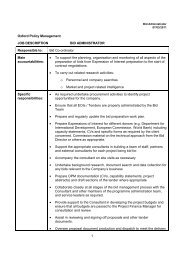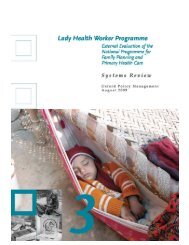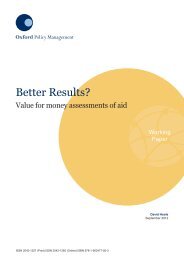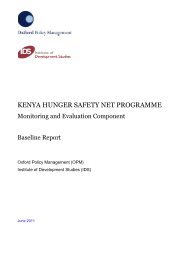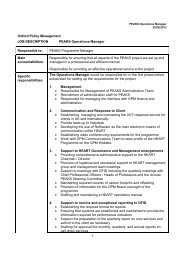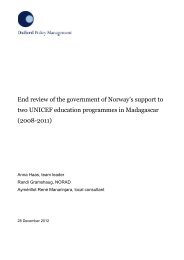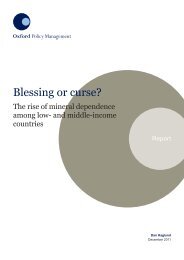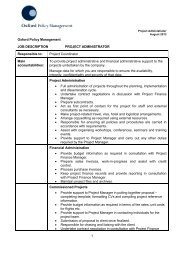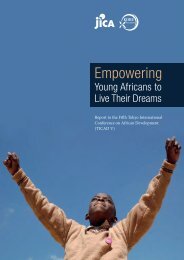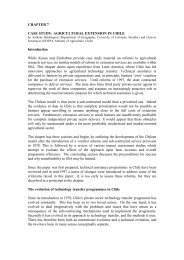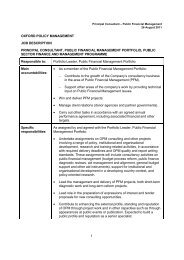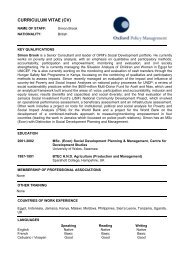LHW Management Review - Oxford Policy Management
LHW Management Review - Oxford Policy Management
LHW Management Review - Oxford Policy Management
You also want an ePaper? Increase the reach of your titles
YUMPU automatically turns print PDFs into web optimized ePapers that Google loves.
Introduction<br />
1 Introduction<br />
The review of management and systems is one of the areas covered by the 4th Evaluation<br />
of the National Programme for Family Planning and Primary Health Care (Lady Health<br />
Worker Programme). 6 This 4th Evaluation of the <strong>LHW</strong>P by <strong>Oxford</strong> <strong>Policy</strong> <strong>Management</strong><br />
began in December 2007 with the objective of evaluating the period covered by the PC-1, 7<br />
from July 2003 to June 2008. 8<br />
The purpose of the 4th Evaluation was to explore whether the Programme had:<br />
• provided the level of services promised:<br />
• to quality standards;<br />
• to the agreed level of coverage;<br />
• including the poor;<br />
• with an impact on health; and<br />
• at a reasonable cost;<br />
• improved performance since the 3rd Evaluation (2000); and<br />
• implemented the organisational developments planned in the Strategic Plan (2003–<br />
11) and the PC-1 (2003–08).<br />
The objectives were to:<br />
• provide the MoH and other stakeholders with accurate, credible and usable<br />
information on the performance of the <strong>LHW</strong>P;<br />
• explore the determinants of performance;<br />
• document the socio-economic benefits to the <strong>LHW</strong>s and the LHSs, their families and<br />
communities of working with the programme; and<br />
• provide findings and policy options that enable the Programme to further strengthen<br />
its performance.<br />
To fulfil these objectives, the key outputs of the evaluation are:<br />
• district- and community-level data collection providing national and provincial<br />
estimates through six different quantitative surveys: the DPIU, health facility, <strong>LHW</strong>,<br />
LHS, household and community. The surveys were based on the questionnaires of<br />
the 3rd Evaluation to ensure comparability of results; 9<br />
• intensive qualitative studies; and<br />
• reviews of management, organisational systems and unit costs.<br />
6<br />
The Programme is officially called the ‘National Programme for Family Planning and Primary Health Care’. It is commonly<br />
referred to as the Lady Health Worker Programme and, hereafter, is referred to as the ‘<strong>LHW</strong>P’ or the ‘Programme’ in this report.<br />
7<br />
The core planning document of the Programme.<br />
8<br />
The most recent independent evaluation of the <strong>LHW</strong> P was commissioned by the Ministry of Health in 1999, and implemented<br />
by <strong>Oxford</strong> <strong>Policy</strong> <strong>Management</strong>. This was the 3rd independent <strong>LHW</strong> Programme Evaluation. The key conclusion of this<br />
evaluation was that the <strong>LHW</strong>P had managed to buck the international and national trends of poor performing Community<br />
Health Worker Programmes and was, in fact, providing a service that had an impact on key health indicators.<br />
9<br />
The quantitative survey covered 5,752 households, 554 <strong>LHW</strong>s and their supervisors and health facilities (FLCFS). It was a<br />
nationally representative sample. The survey was conducted between July and November 2008.<br />
1



